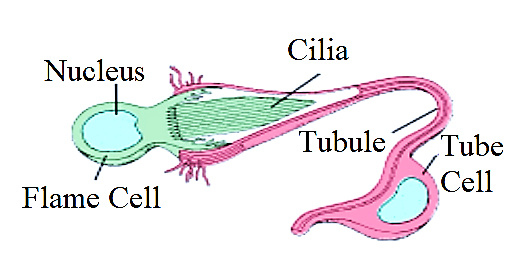
Organisms using protonephridia for excretion are…
(a)flatworms, rotifers, earthworm
(b)amphioxus, cockroach, prawns
(c)planaria, cephalochordates, rotifers
(d)rotifers, cephalochordates, annelids
Answer
562.5k+ views
Hint: Protonephridia or flame cells are specialized excretory systems found in certain groups of organisms. It consists of a network of closed end tubules lacking internal tubules.
Complete answer:
Flame cells are found in the simplest freshwater invertebrates, like Phyla Platyhelminthes, Nemertea, Rotifers and certain Chordates like lancelets.
They are the simplest organisms to have a specially dedicated system for excretion.
Flame cells function like kidneys, by filtering waste materials and expelling them.
Bundles of flame cells are called protonephridia.
Additional Information: Flame cells have a nucleated cell body, with a "cup-shaped" projection, consisting of flagella covering the inner surface. The beating motion of these flagella resembles a burning flame, giving the cells their name. This cup gets attached to a tube cell, whose inner surface is also coated in cilia, which helps in moving the liquid through the tube cell.
The tube opens to the outside through a neuropore, or, into an excretory bladder in trematodes. These cells perform the functions of regulating the osmotic pressure, and also of maintaining the ionic balance in these worms. Microvilli seen in the tube cells reabsorb some of the ions.
The terminal cells are called flame cells if they are ciliated or solenocytes if they are flagellated which are located at the blind end of the protonephridium. Each cell has cilia that beat inside the protonephridia tube, creating an outward current and hence creating partial pressurization in the blind part of the tube.
The pores in the terminal cell are large enough for the smaller molecules to pass, but larger proteins are retained within the body. Selective reabsorption of useful molecules takes place by the canal cells as the solutes pass down the tubule.
So, the current answer is, “flatworms, rotifers, earthworm ”
Note: -The most likely reason for development of Protonephridia was to cope with a hypotonic -environment by removing excess water from the organism.
-Their use as structures for excretion and ionic regulation likely arose secondarily.
-They are a bunch of cilia or flagella, which draw in waste products and excretes them to the outside through a connecting tubule using waving movement.

Complete answer:
Flame cells are found in the simplest freshwater invertebrates, like Phyla Platyhelminthes, Nemertea, Rotifers and certain Chordates like lancelets.
They are the simplest organisms to have a specially dedicated system for excretion.
Flame cells function like kidneys, by filtering waste materials and expelling them.
Bundles of flame cells are called protonephridia.
Additional Information: Flame cells have a nucleated cell body, with a "cup-shaped" projection, consisting of flagella covering the inner surface. The beating motion of these flagella resembles a burning flame, giving the cells their name. This cup gets attached to a tube cell, whose inner surface is also coated in cilia, which helps in moving the liquid through the tube cell.
The tube opens to the outside through a neuropore, or, into an excretory bladder in trematodes. These cells perform the functions of regulating the osmotic pressure, and also of maintaining the ionic balance in these worms. Microvilli seen in the tube cells reabsorb some of the ions.
The terminal cells are called flame cells if they are ciliated or solenocytes if they are flagellated which are located at the blind end of the protonephridium. Each cell has cilia that beat inside the protonephridia tube, creating an outward current and hence creating partial pressurization in the blind part of the tube.
The pores in the terminal cell are large enough for the smaller molecules to pass, but larger proteins are retained within the body. Selective reabsorption of useful molecules takes place by the canal cells as the solutes pass down the tubule.
So, the current answer is, “flatworms, rotifers, earthworm ”
Note: -The most likely reason for development of Protonephridia was to cope with a hypotonic -environment by removing excess water from the organism.
-Their use as structures for excretion and ionic regulation likely arose secondarily.
-They are a bunch of cilia or flagella, which draw in waste products and excretes them to the outside through a connecting tubule using waving movement.

Recently Updated Pages
Master Class 12 Business Studies: Engaging Questions & Answers for Success

Master Class 12 Economics: Engaging Questions & Answers for Success

Master Class 12 English: Engaging Questions & Answers for Success

Master Class 12 Maths: Engaging Questions & Answers for Success

Master Class 12 Social Science: Engaging Questions & Answers for Success

Master Class 12 Chemistry: Engaging Questions & Answers for Success

Trending doubts
What is meant by exothermic and endothermic reactions class 11 chemistry CBSE

Which animal has three hearts class 11 biology CBSE

10 examples of friction in our daily life

One Metric ton is equal to kg A 10000 B 1000 C 100 class 11 physics CBSE

1 Quintal is equal to a 110 kg b 10 kg c 100kg d 1000 class 11 physics CBSE

Difference Between Prokaryotic Cells and Eukaryotic Cells




